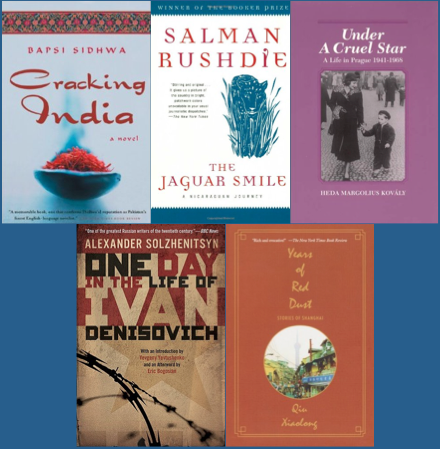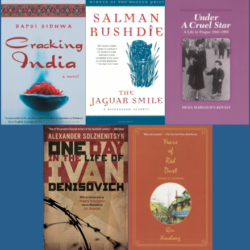Originally published February 2016
One of the best history classes I took last semester was amazing not because of the content, not because of the teacher (although Regina Kazyulina was a pretty great professor), but because of the different approach taken to teach the material. I learned history in an entirely new way, a way that did not include textbooks. Instead of having a thousand paged book to tell me who did what where, I was able to learn history through stories.
Thanks to the different style of learning I was able to understand the conflict surrounding the Sandinistas through journal entries, experience the Partition of India through a child’s eyes, and live through a day in a Soviet gulag. My class had novels, journals, and comics to expose us to history, and while I’ve always loved learning about history, I never realized just how much learning could be enhanced through stories. Each book we read made the history not only more memorable, but more real.
Under a Cruel Star
The first book we read was “Under a Cruel Star: A Life in Prague 1941-1968” by Heda Margolius Kovály. This memoir follows Kovály through her time escaping a concentration camp during World War Two, her time immersing into a newly Communist society, and her struggles for survival once her husband is found guilty in a show trial.
My favorite of the books we read, “Under a Cruel Star” really brought to the forefront parts of history I had never truly understood in depth before. I knew Communism had impacted Czechoslovakia greatly, but I never considered what day to day life was like, let alone hear it from someone who lived through such difficult times. I enjoyed this book because it completely opened my eyes to a period of history I had not realized I enjoyed learning so much about. This memoir helped spark my interest in how World War II and the Cold War impacted eastern Europe, so much so that I am now attending a Northeastern University dialogue to Poland and Prague this summer where I will be studying the affects of the Second World War, with special focus on the Czech Republic and Poland.
One Day in the Life of Ivan Denisovich
The next book on our agenda was “One Day in the Life of Ivan Denisovich,” a novel written by Aleksandr Solzhenitsyn. This novel takes an interesting approach, as it is one continuous stream of events, from the morning the main character, Ivan, wakes up to the moment he goes to sleep. “One Day” tells the story of Ivan, an innocent man in a Soviet gulag, throughout a day in imprisonment.
What I found interesting about this novel was how the constant stream of thought from Ivan throughout the day made the reader feel more connected to the character. Instead of being told how horrifying the Soviet gulag system is, you are experiencing it with Ivan. By focusing on only one day, one that Ivan even considers slightly better than others, rather than the ten years Ivan is sentenced to the camp, Solzhenitsyn increases the impact of the story. You as a reader are able to understand how hard, how cold, how incredibly life changing spending even a day under gulag conditions is, which only amplifies later teachings about Soviet imprisonment.
Years of Red Dust
Another one of my favorites was “Years of Red Dust,” a collection of short stories by Qui Xiaolong. The short stories start in 1949 and end in 2005, highlighting the changes in Chinese society by focusing on the people of Red Dust Lane, and how they respond to major events such as the five year plan, the Great Leap Forward, and the Cultural Revolution.
I found it interesting to see how impactful short stories could be when teaching history. While I tend to prefer a longer narration, I thought that to show so many changes throughout history short stories were the perfect medium. I found it intriguing to see how two characters that had been through similar situations were received so differently depending how society was at the time. This style of writing helped emphasis how tumultuous of a time this was in Chinese history, and helped contextualized why people behaved as they did throughout different events in history.
Cracking India
I found the Partition of India to be one of the more complex areas of history to understand, which is why I found “Cracking India” by Bapsi Sidhwa to be a great novel to read. “Cracking India” tells the struggles of people in Lahore, and how the religious differences between friends puts strains on relationships.
What I enjoyed most about “Cracking India” is how the novel is told through the eyes of a young girl Lenny, who is growing up in a Parsee family. As she ages she starts to become more aware of how an individual’s religious and political values can make a difference in times of great stress. By having a narrator that grows in understanding throughout the novel, so too does the reader begin to understand in greater depth the intensity of the Partition, and how conflict develops between people who had previously sworn life long friendships to one another.
The Jaguar Smile
A series of journal entries from Salman Rushdie, a writer famous for his fourth novel that resulted in a fatwa (Iranian death sentence) being put on his head, made “The Jaguar Smile” an interesting read. Instead of writing about characters meeting influential people of history, or describing a daily life in Nicaragua when the Sandinistas were in power, Rushdie is able to describe his own experiences meeting leaders of the time, and give his opinion of the government.
Although not my favorite, in part because Rushdie seemed biased and assumed knowledge about the Nicaraguan Revolution that I at the time did not have, I still found journal entries an interesting way to approach the subject matter. It is a unique way to get an autobiographical account for a situation, and definitely a more personal one. Although there is going to be bias, as a journal is for one’s own self, it is able to show what someone truly believes at the time of writing as they are currently living and processing what they are writing about.

Having the opportunity to take a class with a dramatically different style than I was used to really helped me develop a new outlook on learning. I might be biased because I love reading, but by reading novels, journals, memoirs and more I feel as though I have deepened my understanding of history. I believe that by experiencing a more personal, more emotional, approach to history, I not only had the opportunity to have what I learned leave a longer lasting impression, but I have had the opportunity to better understand the feelings behind the people that experienced what I learned in class.

Comments are closed